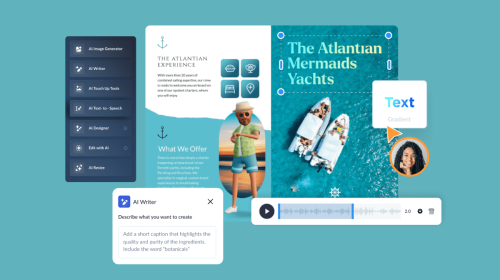
How to Build Strategic Sponsorship Levels With Examples


In 2025, brands are spending a record $1.1B globally on sponsorships and advertising. And that number is expected to grow by 4.49% yearly through 2029.
What does that mean?
Brands are actively investing in partnerships that help them meet their business goals.
That said, most companies aren’t sitting on a pile of cash labeled “sponsorships.”
They’re not throwing money at every pitch that lands in their inbox. Instead, they’re actually reallocating marketing budgets to opportunities that bring the best ROI.
So if you want a piece of that pie, you need to convince them that sponsoring your project will give them a lot of bang for their buck—brand visibility, audience reach, lead generation, community impact, reputation building—you name it.
And that starts with building sponsorship levels that attract the right partners and funding.
In this guide, I’ll walk you through how to structure sponsorship levels that not only make sense on paper but actually convert. We’ll also share real-world examples, tested tips and formats you can make your own.
Sponsorship levels are structured tiers that define the different benefits sponsors receive in exchange for their support for an event or organization.
The benefits listed in sponsorship packages could be financial, in-kind contributions or promotional opportunities.
This tiered approach accommodates sponsors with varying budgets and objectives. It also makes participation possible for organizations of all sizes.
A typical sponsorship levels package includes some of these elements
Here are a few more reasons to consider using sponsorship tiers:
With sponsorship levels, sponsors know exactly what they’re getting upfront. This shows transparency, reduces back-and-forth negotiations and helps you close deals faster.
You can estimate how many packages you need to sell to break even or hit profit goals, whether you're running a one-off event or planning a full-year sponsorship strategy. And because pricing is clear and consistent, it streamlines internal planning and reduces uncertainty.
As Blair Enns mentions in his book, Pricing Creativity, “human beings cannot subjectively perceive absolute values.”
In other words, people need context to evaluate price; they don’t judge it in a vacuum. By offering sponsorship pricing tiers, you provide that context, making it easier for buyers to evaluate options and choose based on perceived value.
Tiered sponsorship makes your offering accessible to a broader range of brands, from budget-conscious startups to big players looking for maximum exposure. If your goal is inclusivity and reach, structured levels let you engage diverse sponsors while maintaining the integrity of your offering.
Not always. While sponsorship levels are widely used for events, they aren’t one-size-fits-all. You can adopt other pricing structures, depending on your event type, size or sponsor goals.
For instance, flat fee sponsorship works well for small or one-off events with a single offering or a uniform audience type.
À la carte pricing is also another option for event sponsorship that allows sponsors to pick specific benefits or items that align with their marketing goals. This approach gives you flexibility while catering to a wide range of sponsor needs.
Keep in mind that sponsorship levels work best when you have a range of benefits to offer and a clear, tiered structure that reflects increasing value.
You can use different types of sponsorship to shape your tiers, including:
Classic sponsorship tiers are structured to offer increasing levels of visibility, access and benefits.
While the tier names may vary, the hierarchy typically looks like this:
A title sponsor is the highest level of sponsorship and receives maximum visibility and influence over the event. Here, the sponsor gains naming rights and is prominently featured in all event branding and communications. You can expect them to be involved in decisions, from shaping event themes to influencing key messaging. Other benefits might include keynote speaking slots, VIP access and exclusive representation.
This tier of sponsor sits just below the title sponsor and enjoys high-level visibility and engagement throughout the event as well. Some benefits at this level include: branding across select materials, prominent logo placement, premium booth space, speaking opportunities, VIP perks and recognition in press releases.
Gold sponsorship is flexible and perfect for brands looking to engage without the intensity of top-tier commitments. Typically, it allows for strong visibility through logo placement, VIP tickets, booth space and mentions in promotional materials.
The silver/bronze usually features modest engagement and brand exposure. For instance, the sponsor might receive medium to small logo placement, general admission tickets and recognition across social media and basic event materials.
This tier is common in nonprofit and small community events. Sponsors at this level contribute more out of community spirit or goodwill than a desire for broad exposure. While the promotion is modest, they may still receive recognition through name listings on event materials, social media mentions and minimal branding.
Here, the sponsor offers non-monetary support (goods or services) instead of direct funding. For instance, sponsors can offer essential resources such as catering, printing, or technical equipment exchange for brand visibility. You can expect recognition through logo placement, event materials or trade-out acknowledgments.
Note: There’s nothing wrong with sticking with the classic tier names. But getting creative with your naming can make your sponsorship proposals stand out. For instance, if you’re organizing a leadership summit, you might name your tiers to reflect influence and impact, such as: 1st tier : “Visionary Sponsor,” 2nd tier :“Leadership Partner,” and 3rd tier: “Community Builder.”
The sponsor name in this example is quite different from the norm.
Structuring sponsorship levels effectively takes careful thought. Here’s a step-by-step guide to help you create impactful sponsorship packages.
To begin, you need a clear understanding of who your potential sponsors are and how they would be a perfect match for your event. This step is critical because it helps you focus on businesses that align with your audience and design perks that will pique your sponsor’s interest.
Here are a few ideas to research about potential sponsors:
A common mistake organizers make is offering only brand awareness. You see this all the time—logo placements, social media shoutouts, branded giveaways and maybe a quick thank-you at the end of an event.
The truth is, most companies aren’t investing just to “be seen.” They’re looking for measurable marketing outcomes. If you can’t offer that, you’re giving them every reason to walk away or worse, spend that same budget on Facebook ads, where they get performance data in return.
That’s why it’s critical to position your benefits through a marketing lens. Speak in terms of engagement, conversions, lead capture and retargeting opportunities.
By structuring your benefits this way, you’re not just offering exposure, you're showing sponsors how your platform can help them drive real, measurable business results.
Jesse Morgan, Affiliate Marketing Manager of Event Tickets Center added the following insights:
“In my experience, the most effective sponsorships are aligned around performance goals and tailored value. For example, one of our top-tier sponsors didn’t care about VIP event passes or logo placement. What they wanted was exclusive placement in our post-purchase emails because they knew that drove actual conversions.
Another sponsor asked to be featured in our TikTok ad creative instead of the event signage because that’s where their audience hangs out. If you take the time to ask each sponsor what success looks like to them, you can build pricing and benefits around outcomes they’ll actually pay for.”
Once you've mapped out benefits that support real marketing goals, the next step is to organize them into sponsorship levels.
Think of it as a value ladder. Each tier should offer deeper engagement and stronger outcomes.
Pro Tip: As you're building these tiers, keep two guardrails in place: one, make sure every benefit you include is realistic for your team to deliver; and two, be sure each tier makes sense from a pricing perspective. The jump in price between tiers should match the jump in value.
Start with names that clearly signal value. While Gold–Silver–Bronze is familiar and easy to follow, you can create more memorable tiers by tailoring them to your brand or industry. Here are a few ideas:
Whatever names you choose, keep them intuitive. Sponsors should immediately understand which tier is the highest and what kind of value each level delivers.
Instead of guessing, anchor your prices on the business impact you're promising. For example, if your top tier gives a sponsor high visibility, lead capture and speaking time, ask yourself: what’s that worth in ad spend or lead gen costs? Use that figure as a benchmark.
Here are some more practical tips to help guide your pricing:
And don’t be afraid to test. You can offer early-bird discounts or include a “Custom Pricing Available” note for brands looking to tailor their involvement.
Here’s what Anton Kovalchuk, founder of QliqQliq recommends:
“To price your sponsorship levels, start with an assessment of your audience and the market in its entirety. Understand the size of your audience-were they high-net-worth individuals, industry heads, or just a broad general group? Pricing should correspond to either the quality or exclusivity of the audience you are actually presenting for the sponsors.
For example, a sponsor paying for the Platinum-level sponsorship must be assured that the brands of such sponsors will reach high-value leads or customers. It is also critical to evaluate the benefits you're giving. If your event or platform provides direct leads to sponsors, puts on a huge audience, or offers one-of-a-kind engagement opportunities, you can charge more for your sponsorship packages. Also, if your event takes place in an even narrower market with very little competition, you can probably charge higher prices for the exclusivity.”
The easiest way to create a polished sponsorship package and save time is to start with one of Visme’s professionally designed templates. Visme offers a wide range of easily customizable sponsorship level templates for different industries.
Simply sign up for a Visme account or sign in if you already have one and you'll be redirected to the Visme dashboard.
Then browse the template library to find a sponsorship template that fits your needs. Every template in Visme’s library is easily customizable. Our drag-and-drop tools allow anyone to create impressive and professional-looking documents with ease, even without design experience.
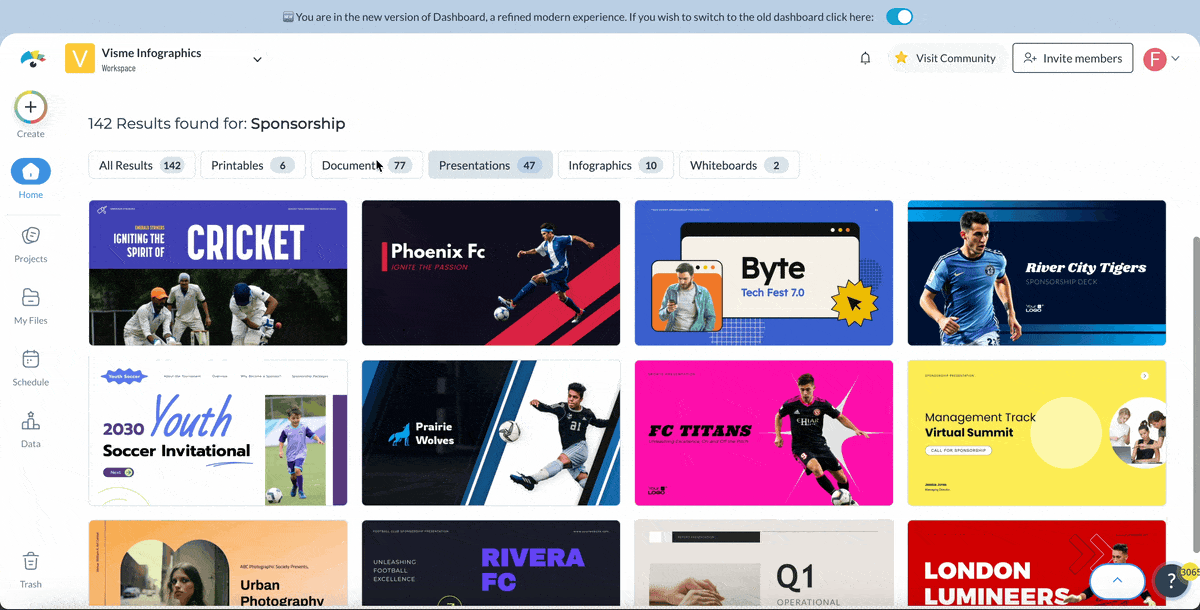
The next step is to swap out the placeholder content in your template with the content you’ve prepared, then tailor the design to match your desired look and feel.
Here are some customization options:
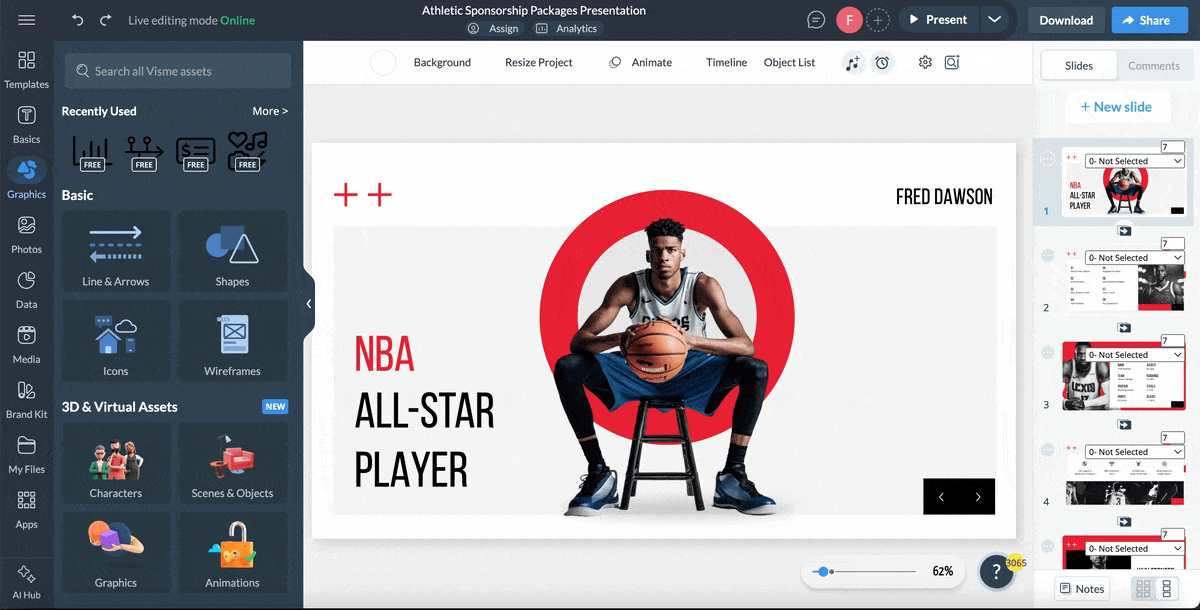
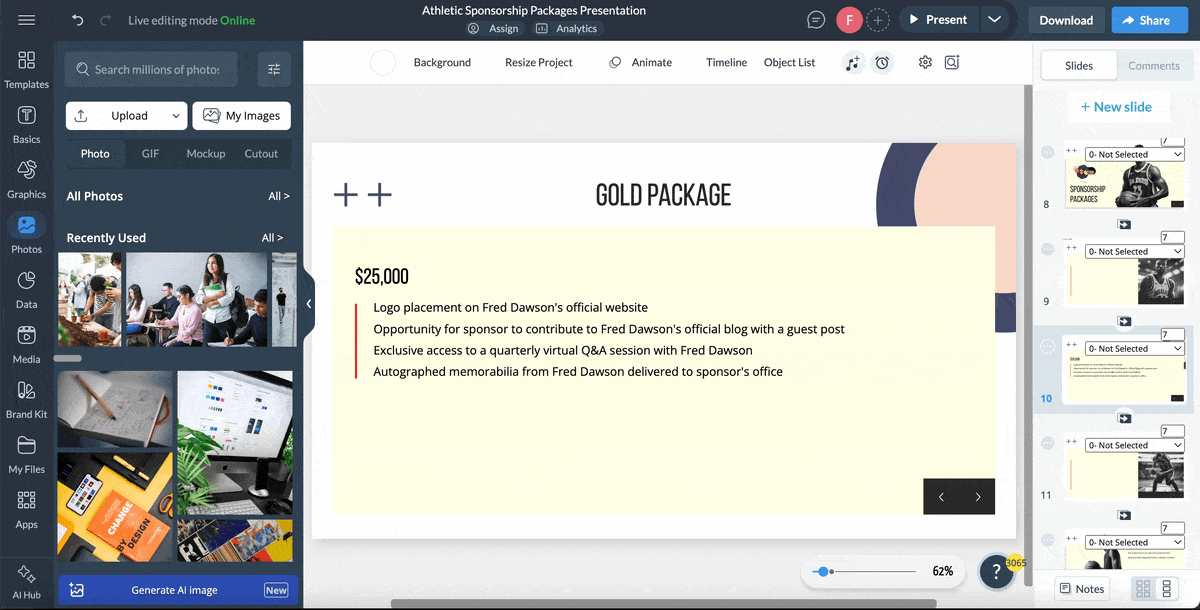
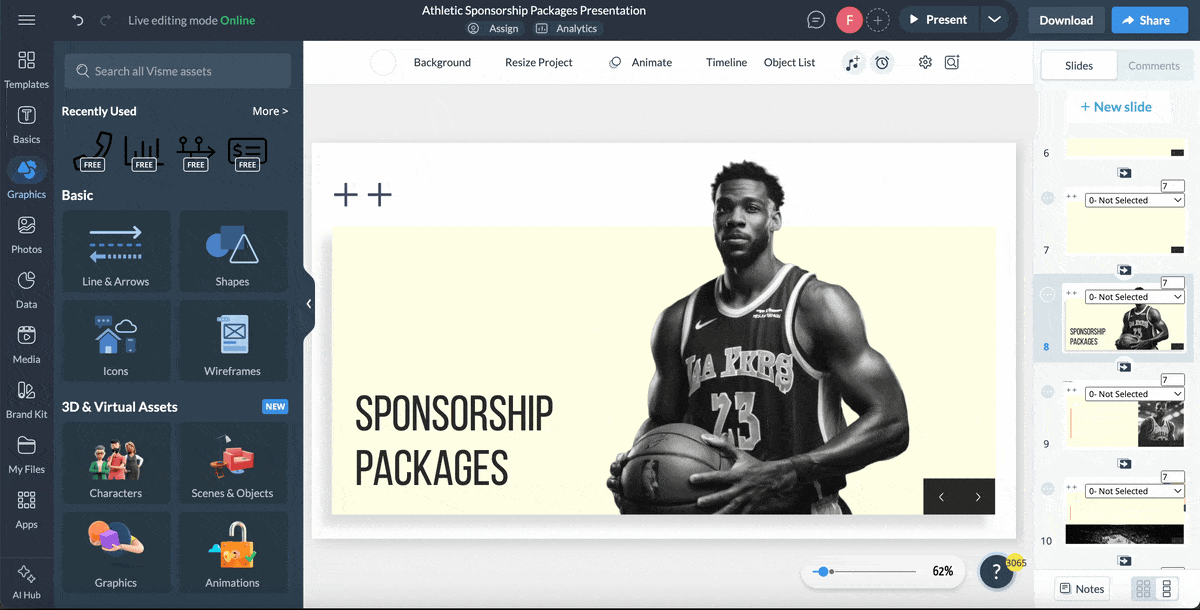
Once you’ve designed your sponsorship levels, you can easily share them with your prospects. With Visme, you can download your design as a high-resolution PDF or PNG and send it directly via email.
Prefer to showcase it on your website? Just hit “Share,” choose “Embed,” and paste the code where you want it to appear.
If you’re torn between the two options, here’s what you need to know:
Fixed packages are usually organized into 3–4 tiers with increasingly valuable benefits. They work well for attracting inbound interest, sponsors seeking quick decisions or when you need to target multiple brands at once.
The downside? They might not fully align with every sponsor’s objectives, which means you risk leaving money on the table.
Custom sponsorship packages, on the other hand, are tailored to a specific sponsor’s needs. They’re perfect for attracting high-value or strategic partners you've directly targeted. These deals often result in stronger brand alignment and better performance, but they take more time and effort to pitch. This makes them slower to close.
That said, you don’t always have to choose between the two. A hybrid approach lets you leverage the best of both worlds.
Start with fixed tiers, but leave space for add-ons or bespoke features. For example, a sponsor could opt for your Silver package and add a branded networking session. Another hybrid strategy is to keep your standard packages public while offering custom deals during private outreaches. This lets you scale efficiently while still accommodating high-value negotiations.
Some good sponsorship level examples to inspire you include:
RARA (Rochester Avon Recreation Authority) developed this community sponsorship program to give local businesses an opportunity to gain visibility through public events.
The layout of the document is colorful, visual and easy to scan, with each sponsorship level clearly broken down in grid format for quick comparison. Including photos of actual events (e.g. Easter Egg Hunts, Daddy-Daughter Dance, Craft & Vendor Shows) adds warmth and will help sponsors easily visualize the impact of their contribution.
Another element that makes this sponsorship package stand out is the wide range of entry points: from $100 to $1,500. With these multiple options, businesses of all sizes can find what suits their budget.
Replicate RARA’s approach using the template below.
To improve the visual appeal of your sponsorship document, consider adding event-themed photos. Visme makes it easy to upload your own images. You can also browse our media library of thousands of visual assets, or even generate custom visuals using the AI image generator.
This 2025 Special Events Sponsorship Package by Guadalupe Centers is a solid example of a clean, vibrant and engaging sponsorship package.
Although the document covers a wide range of events and packages, the presentation doesn’t feel overwhelming. With clearly defined sponsorship levels, benefits tables, bold headings and visual examples, it’s easy to digest from beginning to end.
Each event section is accompanied by real-life images from past events. This adds a personal touch and helps sponsors visualize their brand in the space.
A noteworthy feature is the addition of customized options for each event like “Petting Zoo Sponsor,” “Desert Sponsor,” or “Music Stage Sponsor,” which give potential partners opportunities to align their brand with specific audiences.
You can easily create a simplified version of this sponsorship package using this Visme template.
If you prefer not to start from scratch, Visme AI document generator can generate a tailored layout for you—just drop in a prompt and let it build around your needs.
This annual conference, organized by APNIC, brings together leading Internet and ICT professionals from across the Asia-Pacific region.
The layout of the sponsorship package is sleek and easy to navigate, with each sponsorship level, from Platinum to In-kind, clearly presented in a detailed comparison grid.
What really stands out is the inclusion of options like “display table” access and in-kind contributions such as bandwidth or branded giveaways. These additions make the sponsorship package more accessible for organizations with different budgets or non-monetary ways of contributing.
Here’s a template you can use to replicate this APNIC 48 Sponsorship package.
UAMS developed this Walk Sponsorship package to engage community partners in supporting cancer awareness and patient advocacy.
One standout feature is the addition of fair market value (FMV) at every tier. This helps sponsors understand the tangible value they’re receiving. The distinction is also important for accounting and tax reporting, especially for sponsors who plan to claim deductions.
The overall design comes with bold purples and pinks that reflect the event’s branding and mission of hope. Clean layouts, legible fonts and organized sections make the content easy to scan, while the vibrant event imagery adds an extra sense of warmth.
This package supports a conference that empowers employers with the skills to navigate workplace challenges. What immediately sets it apart is the clear, upfront summary of sponsorship levels and benefits.
Before diving into the tiers, sponsors get a quick overview of what to expect, like who gets inserts in attendee bags, who gets display tables, how sponsors are acknowledged and key deadlines. That kind of at-a-glance clarity is useful for decision-makers who want to scan and act quickly.
Beyond that, there’s a smart use of event elements for strong branding opportunities for sponsors, which makes the package feel less cookie-cutter and more intentional.
Lastly, the simple, visually intuitive design and straightforward copy make the package easy to digest and compare.
You can build something just as compelling using this colorful packet for corporate sponsorship.
ALDcon is an annual gathering of higher education students and professionals that supports academic learning developers across the UK.
These packages immediately create a sense of urgency and exclusivity by highlighting the limited availability of each tier.
The layout is smart and efficient. A clean comparison table makes it easy to scan and evaluate benefits, while a “See Example” link directs users to past sponsors in each tier, which adds instant credibility. Even better is the separate “Purchase Package” column, linking directly to a checkout page. It’s clear, actionable and eliminates friction.
Replicate this ALDcon’s sponsorship package using the template below.
Just like ALDcon, you can use Visme’s interactivity features to add clickable links to details such as past sponsor examples, purchase forms, contact emails, downloadable decks and more.
With Visme, it’s easy to use this design on your landing page. Simply click “Share,” select “Embed,” and paste the code into your desired spot.
&TECH is a global tech community focused on accessibility, inclusion and practical learning. Their sponsorship page is a great example for anyone offering ongoing sponsorships across multiple categories. It combines traditional tiered packages with à la carte tiers. Sponsors have the flexibility to choose packages that align with their goals.
The first element that stands out is the naming structure—each tier reflects the level of sponsorship while allowing room for custom arrangements when needed.
While the page doesn’t use a comparison table, the information is well-organized and easy to navigate. With a wide range of options, sponsors can find a clear entry point based on budget, visibility and engagement goals. The only drawback is that the sheer number of choices could feel a bit overwhelming to some.
Recreate &TECH’s sponsorship package using the template below.
Need to tighten your messaging? Visme AI writer can help you polish your copy. Simply input your prompt and the wizard will perform its magic.
The most common mistakes aren’t about what you’re offering, they’re about how you present and structure it. Here are five pitfalls that can quietly undermine your entire sponsorship strategy (and how to avoid them):
To make sponsorship levels truly effective, you need to frame them within a bigger story about your audience, your mission and the value sponsors will gain by getting involved. Here’s how to present your sponsorship levels:
While you can present your sponsorship levels in various formats, how you use each one should depend on where the sponsor is in their decision-making journey.
Start with your “why”. Sponsors aren’t just buying ad space, they’re investing in an idea, a mission, a community. So take a moment to express your purpose. Why does your event or platform exist? Who is it for? What have you achieved?
But keep it brief. This isn’t the place for a 500-word origin story. A short statement on your vision and mission does the work just like what Women in Tech SEO Community did here:
You can also link to your vision page for deeper context.
When pitching potential sponsors, highlighting how your mission aligns with their CSR goals or brand values is a no-brainer. It builds instant affinity and gives them a bigger reason to say yes.
Now that they know your “why,” show them who it’s for. What’s the size, profile and mindset of your audience?
Be specific. Include numbers that matter to them (like “5,000 monthly listeners” or “70% are founders under 35”).
Take a cue from WTS:
If you have data or have conducted a survey on what your audience values, what they’re looking for or what types of brands they already engage with, include that for added context. This provides a strong reason for why you need the sponsor on board.
Charts and graphs like the ones WTS used to showcase audience data are powerful tools for presenting key metrics. Visme makes this process easy with a variety of data visualization tools, including bar charts, graphs and gantt charts.
Visuals make your pitch more engaging and help validate your claims.
Include screenshots of past events, photos of crowds and social media engagement stats. Embed short clips from your podcast or YouTube channel to bring your content to life. You can even add hover effects to images for added context or embed links for deeper information when needed. With Visme’s interactive features, you can achieve all this easily.
Now comes trust. Sponsors want to know if this has worked for other brands and what the outcome was.
Short, punchy testimonials paired with your past sponsor’s logos are a strong start. But don’t stop at that—share outcomes.
Whenever possible, include a mix of testimonials and case studies from different sponsorship levels. This demonstrates that you’re creating real value, whether a sponsor invests big or starts small.
Being upfront about cutoff dates creates urgency, adds credibility to your offer and helps you stay organized. It ensures that you have enough lead time to deliver on every promise, especially for pre-event benefits.
Moreover, sponsors will appreciate knowing exactly when decisions need to be made, especially if spots are limited or deliverables are time-sensitive.
You’ve shown the value, now make the next step clear and easy.
Instead of something vague like "Let us know if you're interested," provide actionable options. Here are a few options to include on your sponsorship page:
After sharing your sponsorship materials, remember that sponsors are often busy and managing multiple priorities. A delayed response is usually not a “no”; it’s often just a matter of timing. That’s why following up with patience and purpose is key.
Let them know when you'll check in and when you do, bring something valuable to the conversation—whether it’s a testimonial, an update or an offer to customize their package.
Sponsorship levels are structured packages that let sponsors choose their level of investment in exchange for benefits tied to visibility, access or engagement.
The four common types are:
You can go with traditional names like Gold, Silver and Bronze. Another idea is to get creative with theme-based names. The goal is to make each tier instantly clear and appealing.
A sponsorship pyramid visually organizes your packages from the most exclusive (at the top) to the most accessible (at the bottom). It helps show how value increases with investment and gives sponsors a clear hierarchy to consider.
A title sponsor gets top billing and is usually named in the event title (e.g., [Brand] Tech Conference). A presenting sponsor comes just below that acknowledged as “presented by [Brand],” but with slightly less dominance in branding.
Add one or two benefits that feel exclusive and valuable, like inclusion in newsletters or social mentions to an engaged audience.
Event sponsorship levels are tiered packages that offer different sets of benefits to sponsors based on how much they invest.
Sponsorship levels work and they’ve helped countless brands land long-term, high-value partners. However, it’s rarely about the benefits themselves. More often, it comes down to how they’re packaged and presented.
In this article, we have outlined how to prepare and deliver winning sponsorship levels. We’ve also shared expert tips, real-life examples, mistakes to avoid and professional sponsorship levels templates that you can customize.
Now it’s time to turn that knowledge into action. With Visme, you can bring all of that together in one polished, visual format, whether it's a deck, proposal or one-pager.
Ready to start creating sponsorship levels that attract sponsors? Sign up for Visme now!
Design visual brand experiences for your business whether you are a seasoned designer or a total novice.
Try Visme for free